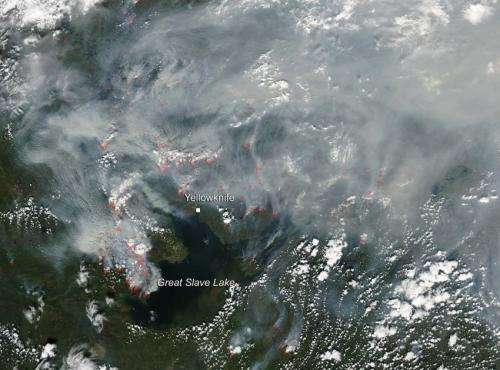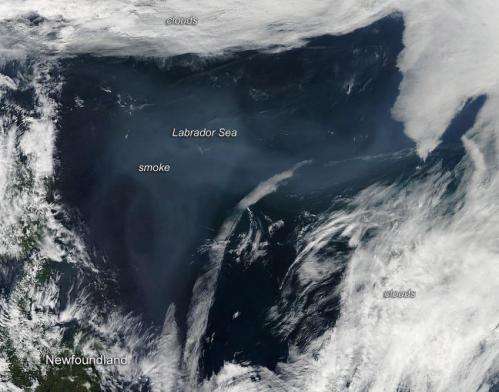Northwest Territories on fire and smoke drifts over Labrador Sea

The fires on the shores of the Great Slave Lake in the Northwest Territories in Canada do not seem in any hurry to be extinguished. In this natural-color satellite image which was collected by the Moderate Resolution Imaging Spectroradiometer (MODIS) aboard the Aqua satellite on July 29, 2014 dozens of fires and copious amounts of smoke are evident. Actively burning areas, detected by MODIS's thermal bands, are outlined in red.
Click on the image above and an image of smoke drifting over the Labrador Sea appears. This smoke has risen off the fires in the Northwest Territories and has been carried along the jet streams to the Labrador Sea which borders both Labrador and Newfoundland and most probably beyond. This natural-color satellite image was also collected by the Moderate Resolution Imaging Spectroradiometer (MODIS) aboard the Aqua satellite on July 29, 2014.
In a recent image feature on the NASA.gov site, smoke was also seen over the Great Lakes in this image: http://www.nasa.gov/content/goddard/smoke-from-canadian-fires-hover-over-great-lakes/

Fire is an obvious danger, but smoke that drifts away from its source and blankets populated areas also has its dangers. The smoke released by any type of fire (forest, brush, crop, structure, tires, waste or wood burning) is a mixture of particles and chemicals produced by incomplete burning of carbon-containing materials. All smoke contains carbon monoxide, carbon dioxide and particulate matter (PM or soot). Smoke can contain many different chemicals, including aldehydes, acid gases, sulfur dioxide, nitrogen oxides, polycyclic aromatic hydrocarbons (PAHs), benzene, toluene, styrene, metals and dioxins. The type and amount of particles and chemicals in smoke varies depending on what is burning, how much oxygen is available, and the burn temperature.
Exposure to high levels of smoke should be avoided. Individuals are advised to limit their physical exertion if exposure to high levels of smoke cannot be avoided. Individuals with cardiovascular or respiratory conditions (e.g., asthma), fetuses, infants, young children, and the elderly may be more vulnerable to the health effects of smoke exposure.
Provided by NASA's Goddard Space Flight Center





















